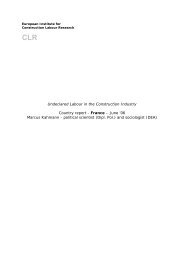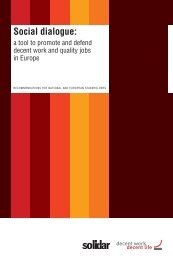Japan – what can we learn? - Construction Labour Research
Japan – what can we learn? - Construction Labour Research
Japan – what can we learn? - Construction Labour Research
You also want an ePaper? Increase the reach of your titles
YUMPU automatically turns print PDFs into web optimized ePapers that Google loves.
Figure 2 C om position of Investm ent in 2005Building 57.6%Private-housing34.8%1.2% Public-housing3.2% Public-non-housingPublic-civilengineeringCivil-engineering 42.4% 18.4%Private-non-housing 32.8%Private-civil-engineering9.6%Private 62.8% Public 47.2%3.1. Civil-engineering stateFirstly, <strong>Japan</strong>ese construction investment put emphasis on civilengineering rather than building construction. This originated from thehistorical development of the nation.• Investment in building and civil engineering is in a ration of 6 to4, which gives a higher priority to civil engineering compared toother developed countries (Figure2). That is because <strong>Japan</strong> hasspecific national land conditions with heavy rain, typhoon, steepstreams, and long coastlines.• From the middle of Feudalism to modern times, plains with riverbasins have been developed as agricultural and fishery,industrial, and urban development regions. Some developmentsco-habited with existing agriculture and fishery; otherdevelopments took the place of these. During these processes,necessary and industrial infrastructures such as conservation andsustainable projects of mountains and rivers, irrigations, landreclamation, bridge formation, coastal revetment gradually had<strong>we</strong>ight in the whole investment.• At the end of the Second World War, the infrastructuredestroyed needed rapid reconstruction. This recovery meantlarge amounts of investment at a high pace over a long term.• During the period of rapid economic growth after recovery fromwar damage, heavy and chemical industry played a key role inCLR News No 2/200622









